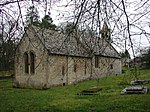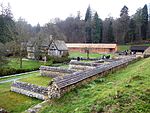Withington railway station (Gloucestershire)

Withington railway station was on the Midland and South Western Junction Railway serving the village of Withington in Gloucestershire. The station opened to passengers on 1 August 1891 with the opening of the section of the line between Cirencester Watermoor and the junction at Andoversford with the Great Western Railway's Cheltenham Lansdown to Banbury line, which had opened in 1881. The station was originally called just "Withington", but was renamed after the Grouping of 1923 allocated the M&SWJR to the GWR, which already had a Withington station at the village of the same name in Herefordshire. Its official name after 1924 was "Withington (Glos)". The station was always lightly used and from 1956 staffing was withdrawn and it was downgraded to halt status. The line closed to all traffic in 1961 and the station buildings were demolished, though traces of one of the platforms remain. An enamel station sign for Withington station is at Winchcombe Railway Museum.
Excerpt from the Wikipedia article Withington railway station (Gloucestershire) (License: CC BY-SA 3.0, Authors, Images).Withington railway station (Gloucestershire)
High Street, Cotswold District Withington
Geographical coordinates (GPS) Address External links Nearby Places Show on map
Geographical coordinates (GPS)
| Latitude | Longitude |
|---|---|
| N 51.8418 ° | E -1.9554 ° |
Address
Withington
High Street
GL54 4BQ Cotswold District, Withington
England, United Kingdom
Open on Google Maps








